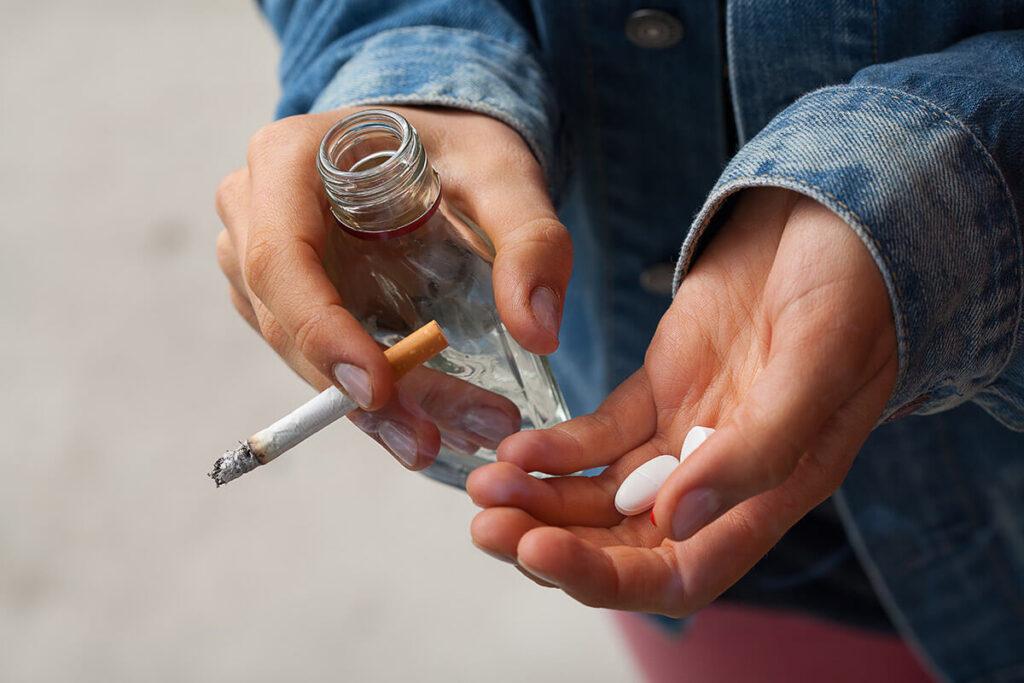Teenage years are marked by numerous changes, challenges, and pressures. Amidst the whirlwind of adolescent experiences, substance abuse stands out as a pervasive issue affecting individuals worldwide. Whether it’s alcohol, tobacco, marijuana, or other illicit drugs, the allure of substances can be enticing for teenagers navigating the complexities of identity formation and social dynamics. In this blog, we delve into the intricate facets of substance abuse in teenagers, exploring its root causes, effects on physical and mental health, and potential solutions for prevention and intervention.
Contents
What is Substance Abuse?

Substance abuse, also referred to as substance use disorder (SUD), encompasses a range of behaviors involving the misuse of substances such as alcohol, prescription medications, and illicit drugs.
It is characterized by compulsive drug seeking and use despite harmful consequences. In older adults and adults alike, substance abuse can manifest in various forms, from occasional misuse to chronic dependence.
Is Substance Abuse Prevalent in Teenagers?
Yes, substance abuse among teenagers is indeed prevalent and remains a significant public health concern. Numerous studies and surveys conducted over the years have highlighted the widespread nature of substance abuse among adolescents.
While prevalence rates may vary depending on factors such as geographical location, socioeconomic status, and cultural influences, the overall trend indicates that a considerable portion of teenagers experiment with or regularly use substances.
Causes of Substance Abuse in Teenagers
Substance abuse among teenagers is a complex issue influenced by a combination of biological, psychological, and environmental factors. Understanding the underlying causes can help identify at-risk individuals and develop effective prevention and intervention strategies. Here are some key causes of substance abuse in teenagers:
- Peer Pressure: Adolescents are highly influenced by their peers. Pressure to fit in or conform to social norms may lead teens to experiment with substances as a way to gain acceptance or popularity within their peer groups.
- Genetics and Biology: Genetics play a significant role in predisposing individuals to substance abuse. Teens with a family history of substance abuse or addiction are at a higher risk of developing similar patterns of behavior due to genetic factors and inherited vulnerabilities.
- Mental Health Disorders: Co-occurring mental health conditions such as depression, anxiety, or trauma can increase the likelihood of substance abuse in teenagers. Some teens may turn to drugs or alcohol as a way to self-medicate and alleviate symptoms of psychological distress.
- Stress and Coping Mechanisms: Teenagers face a variety of stressors, including academic pressures, family conflicts, and social challenges. Substance abuse may serve as a coping mechanism for teens struggling to manage stress or navigate difficult emotions.
- Accessibility: Easy access to drugs and alcohol significantly contributes to substance abuse among teenagers. Factors such as lax parental supervision, availability of substances in the community, and peer networks involved in substance use can make experimentation more likely.
- Sensation-Seeking Behavior: Adolescence is a developmental stage characterized by increased risk-taking and sensation-seeking behavior. Some teenagers may experiment with drugs or alcohol out of curiosity or a desire for novel experiences.
- Media Influence: Exposure to media portrayals of substance use, whether in movies, music, or social media, can glamorize or normalize drug and alcohol consumption among teenagers, influencing their attitudes and behaviors.
- Family Dynamics: Family factors, including parental substance abuse, family conflict, instability, or neglect, can contribute to a teenager’s risk of developing substance abuse issues. Lack of parental involvement, inconsistent discipline, or permissive attitudes toward substance use may also play a role.
- Socioeconomic Factors: Economic disparities and community environments characterized by poverty, crime, or lack of access to resources can increase the likelihood of substance abuse among teenagers. Environmental stressors may exacerbate underlying risk factors and contribute to substance use as a coping mechanism.
Impacts of Substance Abuse on Teenagers

Substance abuse can have profound and long-lasting impacts on teenagers, affecting various aspects of their physical health, mental well-being, relationships, and prospects. Understanding these impacts is crucial for recognizing the severity of the problem and providing appropriate support and intervention. Here are some key impacts of substance abuse on teenagers:
Physical Health Effects:
- Substance abuse can lead to a range of physical health problems, including damage to the brain, liver, heart, and lungs.
- Teenagers who engage in substance abuse are at increased risk of accidents, injuries, and overdose, especially when consuming alcohol or drugs in high doses or combination with other substances.
- Long-term substance abuse can impair cognitive function, memory, and overall physical development, potentially affecting academic performance and future opportunities.
Mental Health Implications:
- Substance abuse is strongly linked to mental health disorders such as depression, anxiety, and psychosis. Teenagers may experience worsening symptoms or develop new psychiatric conditions as a result of substance misuse.
- Substance abuse can exacerbate existing mental health issues and interfere with effective treatment, leading to a cycle of self-medication and worsening symptoms.
Academic and Social Consequences:
- Substance abuse can negatively impact academic performance, attendance, and behavior in school. Teenagers may struggle to concentrate, retain information, and complete assignments, leading to academic underachievement and dropout.
- Substance abuse can strain relationships with family members, friends, and peers. Teens may experience conflict, isolation, and rejection due to their substance use, further exacerbating feelings of loneliness and low self-esteem.
Legal and Behavioral Risks:
- Engaging in substance abuse puts teenagers at risk of legal consequences such as arrest, detention, and involvement with the juvenile justice system. Criminal charges related to drug possession, underage drinking, or driving under the influence can have serious long-term repercussions.
- Substance abuse is associated with risky behaviors such as unprotected sex, driving while impaired, and involvement in violence or criminal activity. These behaviors increase the likelihood of accidents, injuries, and unintended consequences.
Developmental Challenges:
- Substance abuse during adolescence can disrupt normal developmental processes and hinder the transition to adulthood. Furthermore, teens may struggle to establish healthy habits, develop autonomy, and make responsible decisions about their future.
- Chronic substance abuse in adolescence can have lasting effects on brain development, affecting cognitive function, emotional regulation, and impulse control well into adulthood.
Risk of Addiction:
- Teenagers who engage in substance abuse are at increased risk of developing addiction or substance use disorder (SUD). Addiction is a chronic, relapsing condition characterized by compulsive drug-seeking behavior and loss of control over substance use.
- Early initiation of substance use, especially during critical periods of brain development, can increase the likelihood of addiction and make it more challenging to achieve and maintain sobriety later in life.
How To Get Help for Substance Abuse on Teenagers?

Getting help for substance abuse in teenagers requires a comprehensive approach that involves early intervention, supportive resources, and professional assistance. Here are some steps parents, guardians, educators, and teenagers themselves can take to seek help for substance abuse:
- Recognize the Signs: Learn to recognize the signs and symptoms of substance abuse in teenagers, which may include changes in behavior, mood swings, declining academic performance, withdrawal from family and friends, and physical signs such as bloodshot eyes or unusual smells on clothing or breath.
- Open Communication: Create a supportive and non-judgmental environment where teenagers feel comfortable discussing their struggles with substance abuse. Encourage open communication, active listening, and empathy to foster trust and understanding.
- Seek Professional Guidance: Consult with healthcare professionals, counselors, or addiction specialists who can provide expert guidance and support. These professionals can conduct assessments, offer treatment recommendations, and connect teenagers and their families with appropriate resources and services.
- Explore Treatment Options: Explore different treatment options tailored to the teenager’s needs, preferences, and severity of substance abuse. Treatment may include individual counseling, group therapy, family therapy, medication-assisted treatment (MAT), detoxification programs, and residential rehabilitation.
- Attend Support Groups: Encourage teenagers to participate in support groups such as Alcoholics Anonymous (AA), Narcotics Anonymous (NA), or SMART Recovery, which provide peer support, coping strategies, and encouragement for individuals recovering from substance abuse.
- Involve Family and Support Networks: Engage family members, friends, teachers, and other supportive individuals in the teenager’s recovery journey. Collaborative efforts can provide additional encouragement, accountability, and practical assistance in navigating challenges and maintaining sobriety.
- Develop Coping Skills: Help teenagers develop healthy coping skills and alternative ways of managing stress, boredom, and negative emotions without resorting to substance use. Encourage participation in extracurricular activities, hobbies, exercise, and mindfulness practices that promote well-being and resilience.
- Address Underlying Issues: Address underlying issues that may contribute to substance abuse, such as co-occurring mental health disorders, trauma, family conflicts, or peer pressure. Comprehensive treatment should address both the substance use itself and any related physical, emotional, or social factors.
- Create a Supportive Environment: Create a supportive and structured environment at home and in the community that promotes positive behaviors and reinforces sobriety. Furthermore, set clear boundaries, establishes routines, and provides opportunities for meaningful activities and social connections.
- Encourage Persistence and Patience: Recovery from substance abuse is a gradual and ongoing process that requires patience, persistence, and resilience. Encourage teenagers to stay committed to their recovery goals, seek help when needed, and celebrate progress along the way.
Conclusion
Substance abuse is a significant public health concern that affects individuals of all ages, including older adults and adults. By understanding the causes, impacts, and avenues for intervention, we can work towards addressing this complex issue and supporting individuals on their journey toward recovery and improved well-being. Through collaborative efforts between healthcare providers, policymakers, and communities, we can create a more inclusive and supportive environment for individuals struggling with substance abuse.
